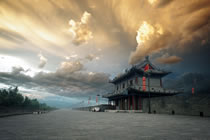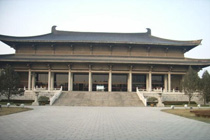Known as the Buddhist Holy Land, Caotang Temple lies about 30 kilometers (25 miles) southwest of Xian, in Caotangying Village of Huxian County. Initially built in 401, the temple became a sacred place where the Buddhist master, Kumarajiva (one of the four Buddhist translators), translated Buddhist scriptures. The temple was a thatch-roofed house, so it got the name of Caotang Temple, meaning Straw Hut Temple.

Kumarajiva - A famous Buddhist master, became a monk at the age of seven. Due to his intelligence and diligence, he mastered the sprit of the Buddhism very well. He led 3,000 Buddhist followers to translate sutras from Sanskrit to Chinese. Instead of metaphrase, he used free translation, which made the scriptures easy to understand.
Features inside the temple:
Kumarajiva Dagoba - Precious Art
Baohui Buddhist Master Preaching Inscription - The real script of the famous calligraphy Liu Gongquan.
The Mist of Caotang Temple - One of the eight famous scenic features in Shaanxi Province A well inside the temple occasionally emits gusts of mist. The legend is that there is a piece of stone on one side, halfway down the well, and whenever there is a snake lying on the stone, the mist comes out, and travels over the countryside. The real cause of the mist, however, might be geothermal vapor, which, once out of the well, gets mixed with the smoke of incense over the temple. Later an elegant pavilion has been built over the well and was named as 'the Misty Well'.
Address: Huxian County, Xi’an
 Xi’an is not only a historical and culture city, but also a trendy city permeated with modern tempo
Xi’an is not only a historical and culture city, but also a trendy city permeated with modern tempo
 Ancient capital Xi'an, the tourism dream is over the time
Ancient capital Xi'an, the tourism dream is over the time
 The cultural and historical significance of the area, as well as the abundant relics and sites, help Xian enjoy the laudatory title of 'Natural History Museum'
The cultural and historical significance of the area, as well as the abundant relics and sites, help Xian enjoy the laudatory title of 'Natural History Museum'
 Countless ancient architecture and valuable historical relics have been preserved above and under the ground
Countless ancient architecture and valuable historical relics have been preserved above and under the ground
 Culture Qin:Museum of Qin Terra-cotta Warriors and Horses
Culture Qin:Museum of Qin Terra-cotta Warriors and Horses
 It is the first multi-functional museum complex which integrates museum, monuments and park
It is the first multi-functional museum complex which integrates museum, monuments and park
 As the symbol of the old-line Xian, Big Wild Goose Pagoda is a well-preserved ancient building and a holy place for Buddhists
As the symbol of the old-line Xian, Big Wild Goose Pagoda is a well-preserved ancient building and a holy place for Buddhists
 Tang Paradise is located in the Qujiang Resort, southeast of the Xian City, Shaanxi Province
Tang Paradise is located in the Qujiang Resort, southeast of the Xian City, Shaanxi Province
 Grand Park Hotel Xi’an
Grand Park Hotel Xi’an
 Xi'an Train Station is ranked as Class A by the nation standard with all the modern facilities
Xi'an Train Station is ranked as Class A by the nation standard with all the modern facilities
 the Chinese dumpling has a long history and is an essential part of celebra-tory meals such as those prepared for the Chinese lunar Spring Festival
the Chinese dumpling has a long history and is an essential part of celebra-tory meals such as those prepared for the Chinese lunar Spring Festival
 This is the famous Halal snacks street in ancient Xi’an City and the only professional food market that runs exclusive Halal food
This is the famous Halal snacks street in ancient Xi’an City and the only professional food market that runs exclusive Halal food
 the Grand Hongkong Restaurant has won many honors and titles
the Grand Hongkong Restaurant has won many honors and titles
 Lying at the foot of Zhongnan Mountain, Xi’an Yajian International Golf Club covers an area of over 214 acres
Lying at the foot of Zhongnan Mountain, Xi’an Yajian International Golf Club covers an area of over 214 acres
 Located just inside the South Gate, Park Qin with the unique decoration to the variety of drink specials
Located just inside the South Gate, Park Qin with the unique decoration to the variety of drink specials
 Kai Yuan Shopping Mall is regarded as one of the biggest shopping mall in Xi'an
Kai Yuan Shopping Mall is regarded as one of the biggest shopping mall in Xi'an
